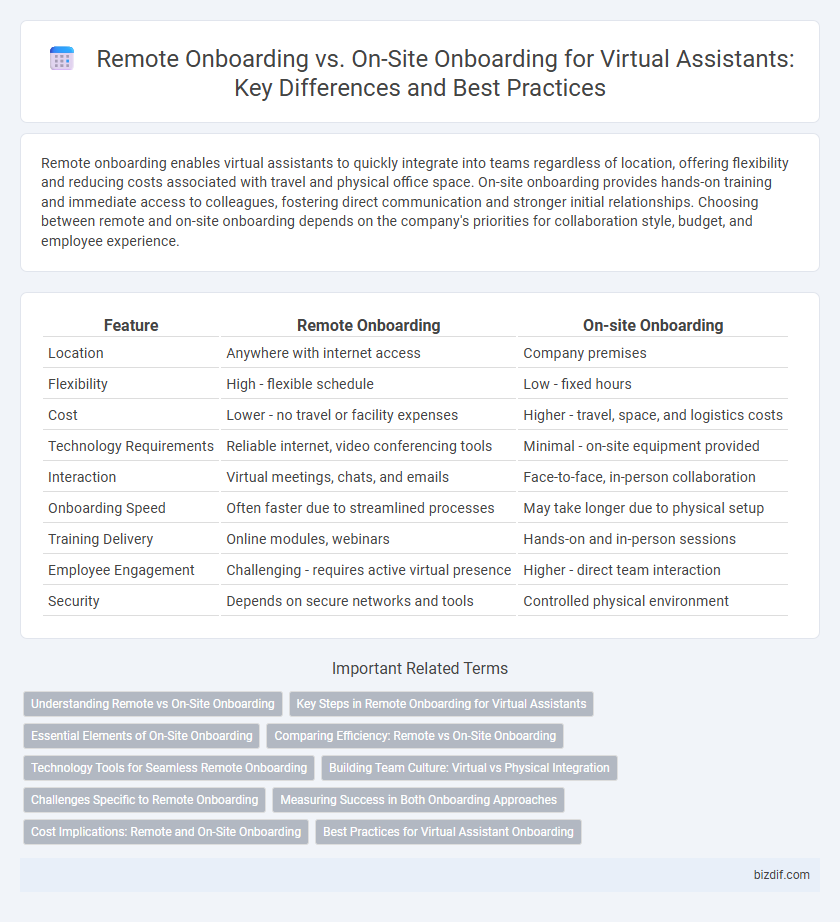Remote onboarding enables virtual assistants to quickly integrate into teams regardless of location, offering flexibility and reducing costs associated with travel and physical office space. On-site onboarding provides hands-on training and immediate access to colleagues, fostering direct communication and stronger initial relationships. Choosing between remote and on-site onboarding depends on the company's priorities for collaboration style, budget, and employee experience.
Table of Comparison
| Feature | Remote Onboarding | On-site Onboarding |
|---|---|---|
| Location | Anywhere with internet access | Company premises |
| Flexibility | High - flexible schedule | Low - fixed hours |
| Cost | Lower - no travel or facility expenses | Higher - travel, space, and logistics costs |
| Technology Requirements | Reliable internet, video conferencing tools | Minimal - on-site equipment provided |
| Interaction | Virtual meetings, chats, and emails | Face-to-face, in-person collaboration |
| Onboarding Speed | Often faster due to streamlined processes | May take longer due to physical setup |
| Training Delivery | Online modules, webinars | Hands-on and in-person sessions |
| Employee Engagement | Challenging - requires active virtual presence | Higher - direct team interaction |
| Security | Depends on secure networks and tools | Controlled physical environment |
Understanding Remote vs On-Site Onboarding
Remote onboarding leverages digital tools and virtual communication platforms to integrate new employees from any location, enhancing flexibility and reducing logistical costs. On-site onboarding provides direct face-to-face interaction, fostering immediate team bonding and hands-on training in the company environment. Understanding the differences in engagement methods, technology use, and cultural immersion is crucial for optimizing employee productivity and satisfaction in both onboarding approaches.
Key Steps in Remote Onboarding for Virtual Assistants
Remote onboarding for virtual assistants requires clear communication channels, comprehensive digital training materials, and structured task management systems to ensure smooth integration. Key steps include setting up secure access to necessary software, conducting virtual orientation sessions, and establishing regular check-ins to monitor progress and address challenges. Utilizing collaboration tools like Slack or Trello enhances productivity and maintains engagement throughout the onboarding process.
Essential Elements of On-Site Onboarding
On-site onboarding incorporates essential elements such as face-to-face interaction, immediate access to physical resources, and real-time training, which enhance employee engagement and retention. It supports direct supervision and peer collaboration, fostering a cohesive team environment and faster adaptation to company culture. These elements are crucial for building personal connections and ensuring comprehensive understanding of job responsibilities.
Comparing Efficiency: Remote vs On-Site Onboarding
Remote onboarding leverages digital tools to streamline training and documentation, resulting in faster integration compared to traditional on-site methods. On-site onboarding offers direct interpersonal interaction, which can enhance immediate team cohesion but often requires more time and resources. Efficiency in remote onboarding is driven by flexibility and scalability, whereas on-site onboarding benefits from hands-on experience and immediate feedback.
Technology Tools for Seamless Remote Onboarding
Technology tools such as video conferencing platforms, digital document signing, and cloud-based project management systems enable seamless remote onboarding by facilitating real-time communication and efficient task tracking. Collaborative tools like Slack and Microsoft Teams support instant messaging and virtual team interactions, ensuring new hires remain engaged and connected. Automated onboarding software streamlines workflows from training modules to compliance tracking, significantly enhancing the remote onboarding experience.
Building Team Culture: Virtual vs Physical Integration
Remote onboarding leverages digital platforms to foster team culture through virtual meetings, collaborative tools, and online social events, promoting inclusivity across geographic boundaries. On-site onboarding emphasizes physical integration by facilitating face-to-face interactions, spontaneous communication, and shared workplace experiences that strengthen interpersonal relationships. Blending both approaches enhances team cohesion by combining the flexibility of remote tools with the tangible connection of in-person engagement.
Challenges Specific to Remote Onboarding
Remote onboarding presents challenges such as limited face-to-face interaction, which can hinder relationship building and team integration. Technical issues including inconsistent internet connectivity and software setup delays often disrupt the onboarding process. Furthermore, remote employees may experience difficulty accessing real-time support and company culture immersion compared to on-site onboarding experiences.
Measuring Success in Both Onboarding Approaches
Measuring success in remote onboarding involves tracking key performance indicators such as time-to-productivity, employee engagement scores, and completion rates of virtual training modules. On-site onboarding success is often evaluated through direct observation, feedback sessions, and immediate integration into team workflows. Both approaches benefit from regular pulse surveys and performance metrics to ensure alignment with organizational goals and employee satisfaction.
Cost Implications: Remote and On-Site Onboarding
Remote onboarding significantly reduces costs by eliminating expenses related to travel, accommodation, and physical office space, making it a cost-effective solution for companies with distributed teams. On-site onboarding incurs higher costs due to the need for dedicated facilities, printed training materials, and in-person support staff, which can increase the overall onboarding budget. Companies experiencing rapid growth often prefer remote onboarding to optimize budget allocation while maintaining efficiency and employee engagement.
Best Practices for Virtual Assistant Onboarding
Remote onboarding for virtual assistants enhances flexibility by utilizing cloud-based collaboration tools and video conferencing to deliver comprehensive training and real-time feedback. Structured workflows incorporating clear communication protocols and digital task management platforms streamline task delegation and performance tracking. Emphasizing regular check-ins and culturally inclusive virtual team-building activities fosters engagement and accelerates acclimation to company culture.
Remote onboarding vs On-site onboarding Infographic

 bizdif.com
bizdif.com